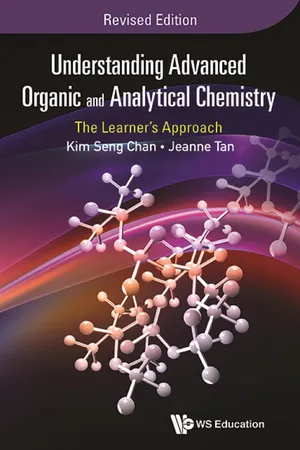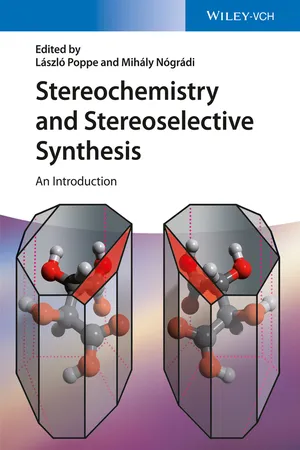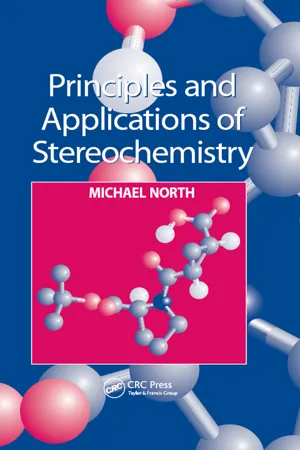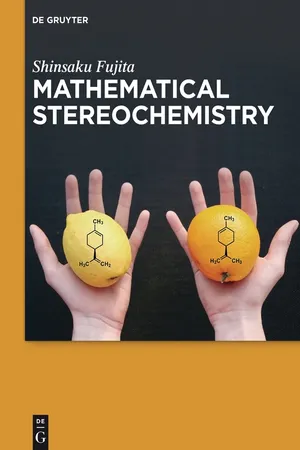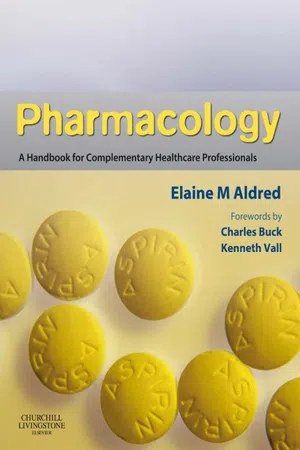Chemistry
Functional Isomers
Functional isomers are a type of structural isomer where compounds have the same molecular formula but different functional groups. This means they have different chemical properties and reactivity. For example, propanol and propanone are functional isomers because they have the same molecular formula (C3H8O) but different functional groups (alcohol and ketone, respectively).
Written by Perlego with AI-assistance
Related key terms
Related key terms
1 of 4
Related key terms
1 of 3
7 Key excerpts on "Functional Isomers"
- eBook - ePub
Understanding Advanced Organic and Analytical Chemistry
The Learner's ApproachRevised Edition
- Kim Seng Chan, Jeanne Tan;;;(Authors)
- 2016(Publication Date)
- WS EDUCATION(Publisher)
CHAPTER 2
Isomerism in Organic Compounds
2.1 Introduction
If a molecule has the molecular formula C4 H8 , does it imply that all the C4 H8 molecules are identical? The alkene, but-1-ene, whose molecule is shown below, has the molecular formula C4 H8 .Yet, C4 H8 also represents the formula for cyclobutane, which belongs to the cycloalkane family:Compounds that have the same molecular formula but different structures are known as isomers. This phenomenon is known as isomerism. The two main types of isomerism are constitutional/ structural isomerism and stereoisomerism. These are further divided into subclasses of which some are discussed in this chapter. Isomers generally have different physical and chemical properties, but they can also have similar chemical properties if they contain the same functional groups. Each specific functional group possesses a characteristic set of chemical reactions.2.2 Constitutional/Structural Isomerism
Constitutional/structural isomers are compounds with the same molecular formula but different structures or structural formulae. Both but-1-ene and cyclobutane constitute a pair of constitutional/structural isomers. The difference in structures can be attributed to either a difference in the arrangement of atoms or due to the presence of different functional groups.Based on the above definitions, constitutional/structural isomerism can be classified into three main types:• chain isomerism;• positional isomerism; and• functional group isomerism.2.2.1 Chain Isomerism
Compounds that exhibit chain isomerism with each other have the same functional group but differ in the way the carbon atoms are connected in the mainskeletal carbon chain of their molecules. In other words, these molecules differ in the degree of branching, hence the term chain isomers - eBook - ePub
Carbohydrate Chemistry
Fundamentals and Applications
- Raimo Alén(Author)
- 2018(Publication Date)
- WSPC(Publisher)
3. Isomerism
3.1.General
A general molecular formula (e.g., Cx Hy Oz Nn ) expresses the kind and number of the constituent atoms of a compound, but it insufficiently represents the structure of the compound in question. A molecular formula can thus correspond to several compounds (isomers) that normally have different chemical and physical properties. Isomers can be defined as chemical compounds with identical molecular formulas (i.e., contain the same number of atoms of each element) that differ from one another in the arrangements of their atoms. This phenomenon is called “isomerism” (in Greek, “isos” means “equal” and “meros” “part”), and it is divided into two main types (Fig. 3.1 ): (i)constitutional isomerismor structural isomerism and (ii)stereoisomerismor space isomerism. Upon examining certain isomers (such as aldoses with the same number of carbon atoms), one does not necessarily find differences based on constitutional isomerism, and finding the actual differences requires detailed comparison of the stereoisomeric properties of the structures.Constitutional isomerism can be divided into three subgroups: (i)functional group isomerism(“function isomerism”), (ii)chain isomerism(“skeletal isomerism”), and (iii)position isomerism(“regioisomerism”), which are discussed in the next chapters with the help of illustrative examples. The general name “structural isomerism” is traditionally used for “constitutional isomerism”. However, since the structure of the compounds can be thought to cause all isomerism, the use of the former term is not recommended.Fig. 3.1.The main types of isomerism and their subtypes.The branch of organic chemistry that examines the three-dimensional structures of molecules,stereochemistry, has gained importance when striving to understand the physical and chemical properties of various compounds. In carbohydrate chemistry, it is also essential to know the stereochemical structure of the compounds. Stereoisomerism can be seen to generally represent the form of isomerism where compounds with the same chemical structure (i.e., the order of attachment of the atoms involved and the location of the bonds between them) differ from each other only in the spatial direction of their atoms or atom groups. This isomerism is divided into (i)optical isomerism(“physical isomerism”), (ii)conformational isomerism, and (iii)geometric isomerism(“cis/trans - eBook - ePub
Stereochemistry and Stereoselective Synthesis
An Introduction
- Mihály Nógrádi, László Poppe, József Nagy, Gábor Hornyánszky, Zoltán Boros(Authors)
- 2016(Publication Date)
- Wiley-VCH(Publisher)
isomerism, recommendations of IUPAC rules [2–4] are of not much help either. Consequently, along with explanations, occasionally we recommend definitions at variance with IUPAC recommendations.- Isomerism: relationship between isomers [2–4].
Isomer: one among compounds (or molecular entities) that have identical chemical formulas but can be isolated and exhibit different physical and/or chemical properties.[According to IUPAC recommendations [2–4], an isomer is one of the several species (or molecular entities) that have the same atomic composition (molecular formula) but different line formulae or different stereochemical formulae and hence different physical and/or chemical properties.]
We have to admit that even our proposed concept of isomerism including isolability is not completely unambiguous,11 since the criterion for isolability cannot be defined precisely. Nevertheless, our proposition is nearer to the everyday praxis of organic chemist than the IUPAC recommendations, since when taking them strictly, then labile, but chiral forms of tertiary amines, the tautomeric pair of acetaldehyde and vinyl alcohol, and further even different conformations of n-butane (e.g., its eclipsed and open conformations) should be regarded as isomers.Isomers can arise (taking into account the criterion of isolability) for multiple reasons (Figure 2.6 ). To distinguish the types of isomers different terms are given.Constitutional isomer: one among isomers, that is, molecules that have different constitutions but the same chemical (molecular) formula. In constitutional isomers, the connectedness - eBook - ePub
- Michael North(Author)
- 2017(Publication Date)
- Routledge(Publisher)
1.5 respectively. In general, these three isomers will undergo the same types of chemical reaction (benzylic oxidation for example), but will do so at different rates, again illustrating their different chemical properties.There is, however, another type of isomerism, one in which all of the atoms in the two isomers do have the same connectivity. A familiar example is found in 1,2-disubstituted alkenes such as compounds 1.6 and 1.7 . In both of these isomeric compounds, the order in which the carbon atoms are joined together is C𝟙–C𝟚=C𝟛–C𝟜 and the only difference between them is that in isomer 1.6 the two methyl groups are on the same side of the double bond, whilst in isomer 1.7 the two methyl groups are on opposite sides of the double bond. Any pair of isomers which have the same connectivity of their atoms but which differ in the relative orientation of those atoms are called stereoisomers.Stereoisomers are the topic of this book and the following chapters will investigate the different structural features which are responsible for stereoisomerism, and discuss the chemical, biological and physical consequences of the formation of stereoisomers. Both organic and inorganic compounds can exhibit stereoisomerism, and examples of each will be found throughout this book. Essentially, stereochemistry is concerned with the shapes of molecules, and the consequences of a molecule adopting a particular shape.Later in this chapter, the way in which the shape of a molecule may be predicted using Valence Shell Electron Pair Repulsion Theory (VSEPR) will be introduced, and the nature of the bonding found in the most common chemical structures will be discussed. At the end of this chapter, the various classifications of stereoisomers will be introduced and these will be discussed in more detail throughout the remainder of this book. However, many of the structures seen later in this chapter are three dimensional, and before they are discussed it is necessary to understand the conventions used when representing three dimensional structures on a two dimensional piece of paper. - eBook - ePub
Chemistry for Pharmacy Students
General, Organic and Natural Product Chemistry
- Lutfun Nahar, Professor Satyajit D. Sarker(Authors)
- 2019(Publication Date)
- Wiley(Publisher)
Chapter 4 Organic FunctionalGroupsLearning Objectives
After completing this chapter, students should be able to:- recognize various organic functional groups;
- outline the properties, preparations, reactivity and reactions of various organic functional groups;
- discuss the importance of organic functional groups in determining drug action and toxicity;
- describe the significance of organic functional groups in determining stability of drug molecules.
4.1 ORGANIC FUNCTIONAL GROUPS: DEFINITION AND STRUCTURAL FEATURES
All organic compounds are grouped into classes based on characteristic features called functional groups. A functional group is an atom or a group of atoms within a molecule that serves as a site of chemical reactivity. Simply, functional groups are structural units in organic molecules that are portrayed by specific bonding arrangements between specific atoms. Carbon combines with other atoms such as H, N, O, S and halogens to form functional groups. The most important functional groups are shown in the following table, with the key structural elements and a simple example.A reaction or chemical reaction is the chemical process by which one compound is transformed into a new compound. Thus, functional groups are important in chemical reactions. It is important to recognize these functional groups, because they dictate the physical, chemical and other properties of organic molecules including various drug molecules and drug interactions. Some examples of drug molecules containing various functional groups may include fluoxetine, commonly known as Prozac® - eBook - ePub
- Shinsaku Fujita(Author)
- 2015(Publication Date)
- De Gruyter(Publisher)
Def. 2.5 .Exercise 2.1. Discuss the difference between the term constitutionally-anisomeric (Def.2.8) and the term constitutionally-isomeric (Def. 2.9 ). See Subsection 2.1.5 .For example, the isomers listed in Fig. 2.2 (with the molecular formula C3 H8 0) is determined to be a set of graphs:where each symbol represents a graph corresponding to the 3D structure listed in Fig. 2.2 . The set of graphs (Eq. 2.11 ) corresponds to the set of equivalence classes of stereoisomers (Eq. 2.9 ) in a one-to-one fashion: 2-4g^ (2-4), 2-5g^ (2-5), and 2-6g^ (2-6). Such a one-to-one correspondence (bijection) between a set of constitutional isomers (due to Def.2.9) and an equivalence class of stereoisomers (due to Def. 2.5 ) holds true in general.Theorem 2.1. A set of constitutional isomers due to Def. 2.9 corresponds to a set of equivalence classes of stereoisomers due to Def. 2.5 in a one-to-one fashion.The conventional definition of an isomeric relationship exhibits dual nature as summarized in Table 1.1 (page 6). This conventional definition of an isomeric relationship can be replaced by Def. 2.6 (an isomeric relationship) because of Theorem 2.1, where the conventional 2D-based definition (Def. 2.9 ) is successfully linked to the present 3D-based definition of a stereoisomeric relationship (Def. 2.5 ). Thereby, the dual nature (Table 1.1) is avoided rationally. Note that such an equivalence class of stereoisomers is based on 3D structures, where both Def. 2.5 (a stereoisomeric relationship) and Def. 2.6 - eBook - ePub
Pharmacology
A Handbook for Complementary Healthcare Professionals
- Elaine Mary Aldred(Author)
- 2008(Publication Date)
- Churchill Livingstone(Publisher)
Modern medication tends to be known by its brand name, which is likely to be different in each country. For example, the chemical name for the drug Prozac is fluoxetine, but ‘Prozac’ – the brand name – is the name most commonly used. Looking at the chemical structure will leave you in no doubt as to whether you are looking at the same chemical compound.If you are looking at medication in an international context, it is best to search by the chemical name, although several online search mechanisms will look specifically for medication (see Chapter 42 ‘Information gathering’, p. 342 ).Passage contains an image
Chapter 6 IsomersChapter contentsStructural Isomers 35Stereoisomers 36What happens when a compound has more than one chiral centre? 38Alkaloids 39If two compounds have the same molecular formulae (in other words, the same number and types of atoms) but the atoms are arranged differently, they are classed as isomers . Care has to be taken with this definition, however, as the two examples in Figure 6.1 are not isomers but the same molecule bent into a different shape because the mobility that the single bond allows it. In this example, the arrangement of atoms differs by their arrangement in space only.Figure 6.1 Compounds that are not isomers.Bear in mind that a single bond enables a molecule to rotate freely around it, so the apparent change in the shape in the molecule does not make it an isomer (compare this with the limited rotation around a double bond, see Figure 6.5 ).There are several different types of isomer: • Structural isomers: chain isomerism, positional isomerism. • Stereoisomers: enantiomers, diasteroisomers, E-Z isomers.Structural Isomers
Chain isomerism
Chain isomers (Figure 6.2(i) ) occur because functional groups can branch off from the main carbon backbone. The number of carbon and hydrogen atoms remains the same but the structures are very different.Figure 6.2
Index pages curate the most relevant extracts from our library of academic textbooks. They’ve been created using an in-house natural language model (NLM), each adding context and meaning to key research topics.
Explore more topic indexes
Explore more topic indexes
1 of 6
Explore more topic indexes
1 of 4
